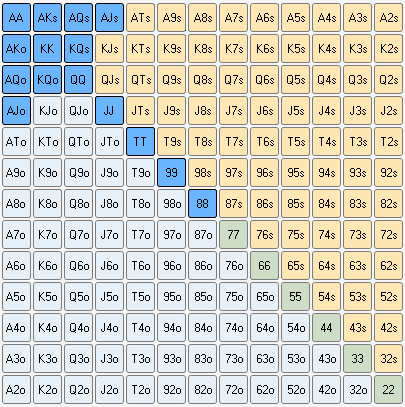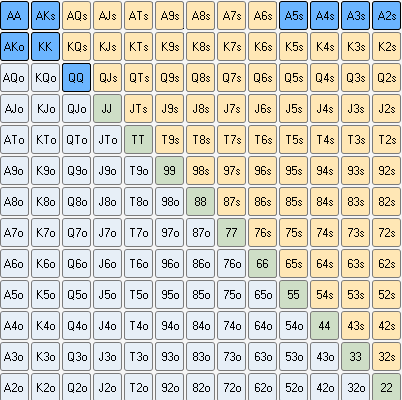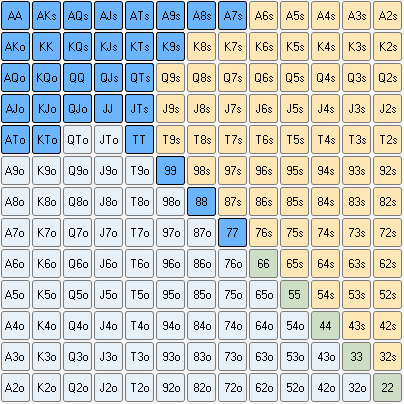Chapter 4: 3-betting and 4-betting
What is a 3-bet?
A 3-bet occurs when the original preflop raiser is re-raised by another player.
A 4-bet occurs when a 3-bet is re-raised by any player.
The reason it is called a 3-bet is that the automatic posting of the blinds is considered the first bet; the second bet (2-bet) is when a player raises the blinds instead of calling them; and the third bet (3-bet) is the re-raising of the 2-bet.
3-bet poker statistics take much longer to yield useful data when compared to common poker stats such as VPIP and PFR. Once you get at least 1,000 hands on your opponent, you can be reasonably certain that you have good information on their tendencies. If you only have 100 hands on your opponent, be very careful before changing your strategy too much.
What do we mean by changing your strategy?
Remember, you need to learn to play solid poker first. Only after that should you exploit your opponent’s major flaws. As beginners, many players 3-bet only very strong hands. A major step in the journey from beginner to intermediate player is understanding 3-betting at a deeper level and moving into a wider 3-betting range.
Why do we 3-bet?
There are two reasons to make any bet in poker. The first is for value. The second is to bluff. Thus, all 3-betting will either be for value or to bluff your opponents off their hands.
A good first concept to understand is capped versus uncapped ranges.
A player opening from the first position can have hands in their range as strong as AA and KK. This player’s range is considered uncapped.
However, if a second player flat calls the first player preflop, then that player has a capped range. Because the second player would almost always 3-bet hands as strong as AA and KK, these hands are essentially removed from their range. The second player is therefore going postflop with a capped range against an uncapped range.
However, if a player 3-bets the original raise, then AA and KK can now be in their range. If the original raiser simply calls, then that player is the one with the capped range, as they would most likely 4-bet a hand as strong as AA or KK.
When you 3-bet, you have an uncapped range, which makes it more difficult for your opponent to play against you. You go to the flop with the initiative and you have all your strongest hands available to you.
What is a good 3-bet percentage?
Strong, winning players do not 3-bet only their strongest hands. At the low stakes, a good 3-bet percentage will be around 5%–9%. Players can win aggressively with 3-bet percentages as high as 11%, however generally for beginners it is much easier to play with a tighter 3-bet range.
It is much easier to play against a player that 3-bets only 2%–3% of their hands compared to a player who 3-bets 6%–8% of their hands. When you are against the first player, you know that they probably only have JJ+ and you can therefore easily fold hands against their 3-bet range.
When should you 3-bet?
It is easy to understand 3-betting for value. When playing solid, aggressive poker, a good rule is to always 3-bet your strongest hands. This allows you to play much larger pots with your strongest hands, and it balances your 3-bet range when you want to include bluffs and weaker hands.
This is just scratching the surface of 3-bet theory, however.
When you are deciding to 3-bet, you must look at the hand range that your opponent is opening from each position using the unopened preflop raised statistic (UOPFR). Using a hand range program like Equilab, you can estimate the range of hands they are opening, and decide what range of hands to flat call or re-raise with. In order to profitably flat call your opponent’s opening range, you ought to have hands strong enough to have an equity advantage against their range. (Equity just means your chance of winning the pot based on the strength of your hand.) This equity advantage combined with your positional advantage postflop needs to be large enough to overcome the fact that you have a capped range against their uncapped range.
When choosing hands to re-raise in a polarized strategy (which will be explained further below), you need to be raising hands that are stronger than their range (value) and slightly too weak to call (your bluffs). It does not make sense to start 3-bet bluffing as a beginner with a hand like 34 suited. It is much better to use a hand like A4 suited, which does much better against their calling range, while also blocking their strongest hands.
For example, if you are all in preflop against KK with your bluff hand of A4 suited, you win roughly a third of the time!

The additional advantage of using a hand like A4s in your bluffing range is that it makes it less likely for your opponent to have strong hands like AK or AA, because you have one of the only four aces in the deck.
Before you attempt a 3-bet, however, you need to understand the relevant poker statistics and their acronyms in poker tracking software such as Poker Copilot. They are:
- Fold to 3-bet preflop in position (F3B IP) ;
- Fold to 3-bet preflop out of position (F3B OOP) ;
- Folded to cbet on flop in 3-bet+ pot (FCB_3) ;
- 4-bet preflop (4B).
Fold to 3-bet
The fold to 3-bet statistic is the most important one to understand. In a balanced strategy, you will have a fold to 3-bet of somewhere near 55%. However, at the lower stakes this will usually be higher, because players there are generally weighted towards value when they 3-bet.
If a player is folding 30% or less to 3-bets, then you need to raise them primarily for value. This will involve using a depolarized range.
If a player is folding 65% or more to 3-bets, then you need to raise them primarily as a bluff. This will involve using a polarized range.
The percentages of fold to 3-bet work on a sliding scale. The closer they are to 30% or less, the more you want to be weighted towards value. The closer they are to 65%, the more bluffs you want to work into your range.
Folded to cbet on flop in 3-bet+ pot
The most useful statistic that will determine your preflop strategy is “Folded to continuation bet on flop in 3-bet+ pot”.
This statistic can change the way that you create your ranges. Against players who have a high fold to flop continuation bet, you can start opening your range to have a slightly higher concentration of bluffs.
4-bet preflop
Be wary of 3-betting a player who has a high 4-bet percentage. Against these players, you can develop a strategy of 3-betting a tighter range and 5-betting them (which is often an all-in preflop) if they are calling too much, or flat calling their 4-bets with your range advantage and playing postflop.
Depolarized versus polarized 3-betting ranges
When we 3-bet a range of hands that is stronger than the range of hands our opponent is opening, we are raising primarily for value. This is called a depolarized strategy.
A depolarized range might look like this:

A depolarized range only contains value hands of varying strength. Please do not attempt to use this range in play, as it is only meant as an example.
When we 3-bet a range of hands that includes both hands that are stronger and hands that are weaker than our opponents’ range, then we are raising both for value and as a bluff. We balance this range depending on their fold to 3-bet poker statistics. This is called a polarized strategy.
A polarized range could look like this:

In this range, you would be 3-betting QQ, AKo, AK, AKs and AA for value, planning to 5-bet all in against a 4-bet. You would be 3-betting A2s–A5s as a bluff, and planning on folding to a 4-bet. In this situation, you have 16 combos of hands that are bluffs, and 34 that are value, which is a good range for beginners to become more comfortable. Please do not use this 3-betting range in your games; it is only an example meant to illustrate how a 3-betting range can be constructed.
3-bet sizing
You will want to 3-bet to a size of slightly over pot against most opponents. Against players who are folding too often against 3-bets, you can use a slightly smaller sizing and add in more bluffs. Against players calling too often against 3-bets, you can use a slightly larger sizing, and have a higher ratio of value to bluffs.
Using 3-bets to defend the blinds
3-betting is a very powerful strategy against players who are attacking your small and big blinds.
The small blind is the most difficult blind to defend. This is because if you flat call preflop, the player in the big blind will have a very good price to call compared to the size of the pot. This puts you into situations where you are forced to play out of position against two other players. Additionally, your opponents know that the range of hands you have is capped, because you would always be 3-betting your strongest hands.
A stronger strategy for beginners is to use a 3-bet or fold strategy from the small blind. Unless you have a very good reason to flat call (if, for example, you have a very passive player in the big blind and you have a pocket pair that has great implied odds when you hit your set), then you should be either folding your hand or 3-betting.
To defend your big blind, you will 3-bet depending on your opponent, but with the understanding that, because you are out of position against everyone but the small blind, you need to have a strong range.
In general, when faced with a steal attempt from the button, you can at least raise the top 15% of your hands. If you are against a player who is folding too much to 3-bets, folding too much to cbets in 3-bet hands, or opening too wide on the button, you can widen your 3-betting range in order to exploit the mistakes in their game.
Below is an example of a depolarized 15% range that can be used when the button attempts to steal the blinds. Like all of the hand ranges in this guide, it is designed for beginners and is therefore on the tight side. As you get more comfortable, or when you see good opportunities to 3-bet against weaker players, you can expand this range to include hands such as T9s–Q9s, all of the pocket pairs, and all of the suited aces.

What do you do if you are facing a 3-bet?
If you have raised preflop and are facing a 3-bet, the first step is to look at your opponent’s 3-bet percentage from the position they are in. For example, good players usually have a much higher 3-betting range from the small blind than from middle position.
You can then use a program like Equilab to input their percentage and get a good idea of what hands they are 3-betting. For example, a player with a 4% 3-bet from the button may be only 3-betting 99+ and AQs+.
What do you do in this case? With almost all your range, you fold. Why? Against someone who is 3-betting purely for value, you beat them by folding exploitatively.
4-betting preflop
4-betting depends completely on the 3-bet range of your opponents. If your opponent is only 3-betting AA and KK, then you can only 4-bet AA against your opponent.
You can use the poker statistic folded to 4-bet preflop (F4B) to help with your decision. If a player is folding 40% or less to 4-bets, then the range of hands that you 4-bet with needs to be primarily for value. If your opponent is folding 60% or more against 4-bets, then your range of hands to 4-bet can be more focused on bluffs.
Good hands to think about as 4-bet bluffs are small suited aces.
What do you do against an active 3-better to your left?
It can be incredibly frustrating to play at a table where someone seems to be 3-betting your opens again and again. Against a weak, overly aggressive player, you can combat their strategy by either 4-betting light or simply calling them with a strong range of hands and letting them bluff off their stack when you catch a piece of the board.
Against a strong, aggressive 3-better to your left, you will be playing large pots out of position with a capped range versus their uncapped range when you flat call. This is one of the toughest spots to play profitably in poker. While using a good 4-betting strategy and analyzing their 3-bet range to discover which hands to call with is the long-term strategy for success, as a beginner it simply may be better to leave the table.
If you do decide to stay at the table (maybe because there are many other poor players there), then the quickest and easiest way to adapt is to simply start raising a tighter range of hands first into the pot so that your range can handle the heat of their active 3-betting.